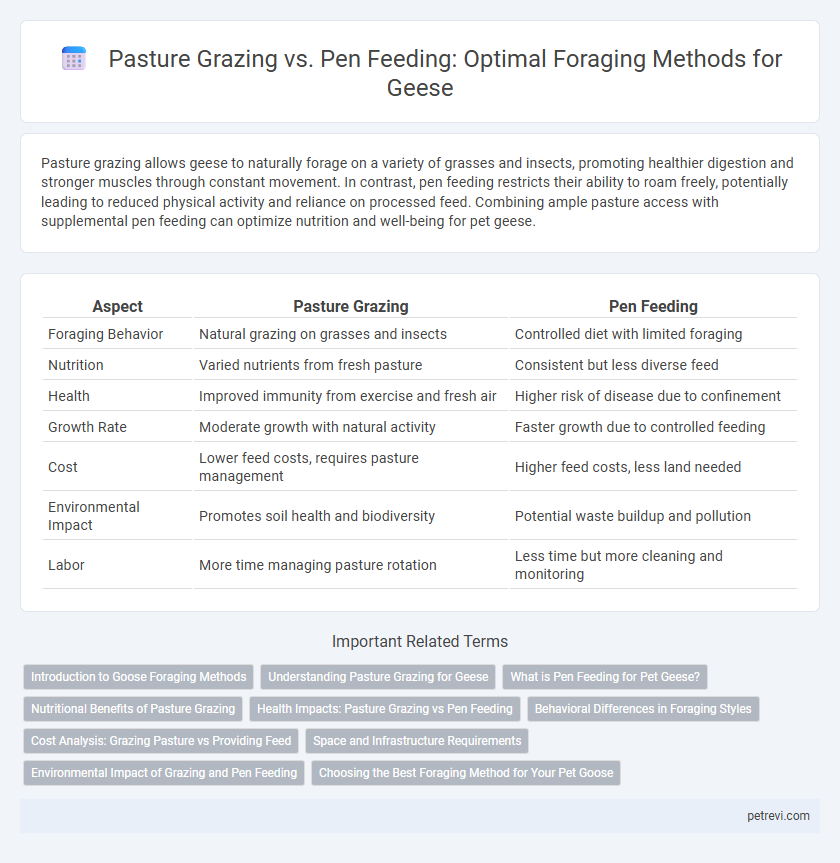Pasture grazing allows geese to naturally forage on a variety of grasses and insects, promoting healthier digestion and stronger muscles through constant movement. In contrast, pen feeding restricts their ability to roam freely, potentially leading to reduced physical activity and reliance on processed feed. Combining ample pasture access with supplemental pen feeding can optimize nutrition and well-being for pet geese.
Table of Comparison
| Aspect | Pasture Grazing | Pen Feeding |
|---|---|---|
| Foraging Behavior | Natural grazing on grasses and insects | Controlled diet with limited foraging |
| Nutrition | Varied nutrients from fresh pasture | Consistent but less diverse feed |
| Health | Improved immunity from exercise and fresh air | Higher risk of disease due to confinement |
| Growth Rate | Moderate growth with natural activity | Faster growth due to controlled feeding |
| Cost | Lower feed costs, requires pasture management | Higher feed costs, less land needed |
| Environmental Impact | Promotes soil health and biodiversity | Potential waste buildup and pollution |
| Labor | More time managing pasture rotation | Less time but more cleaning and monitoring |
Introduction to Goose Foraging Methods
Pasture grazing allows geese to forage naturally on grasses and weeds, promoting healthier digestive systems and reducing feed costs. Pen feeding confines geese to a controlled environment where their diet consists mainly of prepared feed, offering precise nutritional management but limiting natural behaviors. Understanding these foraging methods is crucial for optimizing goose growth, health, and welfare in various farming systems.
Understanding Pasture Grazing for Geese
Pasture grazing for geese enhances natural foraging behavior by providing access to diverse grasses and insects, improving nutrient intake and overall health. This method promotes sustainable land management through natural weed control and soil fertilization by goose droppings. Compared to pen feeding, pasture grazing reduces feed costs and supports animal welfare by allowing free movement and natural diet.
What is Pen Feeding for Pet Geese?
Pen feeding for pet geese involves confining the birds to a designated area where they receive measured portions of formulated feed, ensuring consistent nutrition and controlled intake. This method reduces exposure to parasites and predators commonly found in pasture grazing, while allowing easier monitoring of health and growth. Pen feeding supports stable weight gain and nutrient balance but may limit natural foraging behaviors and biodiversity intake.
Nutritional Benefits of Pasture Grazing
Pasture grazing provides geese with a diverse range of natural forage, including grasses, herbs, and insects, that enhances their nutrient intake compared to pen feeding. The fresh pasture diet is rich in essential vitamins, minerals, and fiber, promoting better digestion and stronger immune function. Access to varied natural forage supports healthier growth rates and improves overall bird welfare by mimicking their natural foraging behavior.
Health Impacts: Pasture Grazing vs Pen Feeding
Pasture grazing significantly improves goose health by promoting natural foraging behavior, enhancing muscle development, and reducing stress levels compared to pen feeding. Exposure to diverse vegetation and insects in pasture supports better nutrition and gut microbiota balance, lowering the risk of digestive disorders. In contrast, pen feeding often leads to sedentary habits, higher susceptibility to diseases, and increased aggression due to confined living conditions.
Behavioral Differences in Foraging Styles
Geese exhibit distinct behavioral differences in foraging when comparing pasture grazing with pen feeding; pasture grazing encourages natural foraging instincts, promoting extensive movement and diverse dietary intake through selective grazing on grasses and herbs. Pen feeding restricts physical activity, leading to less varied diets and often increased competition for food, which can cause stress and aggression among geese. These behavioral variations impact overall health, digestion efficiency, and social interactions within the flock.
Cost Analysis: Grazing Pasture vs Providing Feed
Pasture grazing significantly reduces feed costs for goose foraging by allowing natural consumption of grasses and insects, minimizing the need for purchased feed. Pen feeding incurs higher expenses due to the continuous requirement for commercial feed, bedding, and labor associated with maintenance. Analysis of long-term costs highlights pasture grazing as a more economical option, especially when considering the sustainability and health benefits for geese.
Space and Infrastructure Requirements
Pasture grazing for geese requires expansive, well-maintained grassy areas to support natural foraging behaviors and ensure adequate nutrition. In contrast, pen feeding demands minimal outdoor space but necessitates investment in secure fencing, feeders, and shelter infrastructure to manage confinement and prevent predator access. Spatial efficiency favors pen feeding, while pasture grazing promotes animal welfare through ample roaming space and natural diet opportunities.
Environmental Impact of Grazing and Pen Feeding
Pasture grazing allows geese to naturally forage on grasses, promoting soil health through nutrient recycling and reducing the need for synthetic fertilizers. Pen feeding concentrates manure in confined areas, increasing the risk of nutrient runoff and water contamination. Sustainable pasture management minimizes environmental degradation while pen feeding demands careful waste management to mitigate ecological impact.
Choosing the Best Foraging Method for Your Pet Goose
Pasture grazing provides geese with natural forage rich in nutrients, promoting their digestive health and reducing feed costs. Pen feeding offers controlled diet management, allowing precise nutrient intake and minimizing exposure to parasites and predators. Selecting the optimal foraging method depends on balancing animal welfare, environmental conditions, and resource availability to ensure your pet goose thrives.
Pasture grazing vs Pen feeding for Goose foraging Infographic

 petrevi.com
petrevi.com